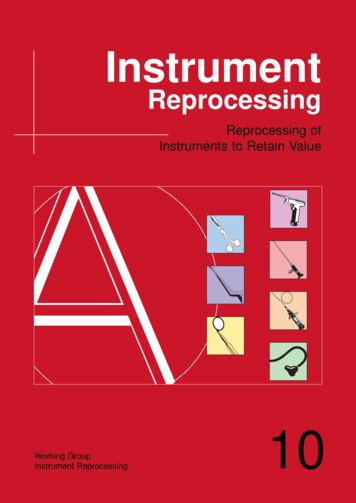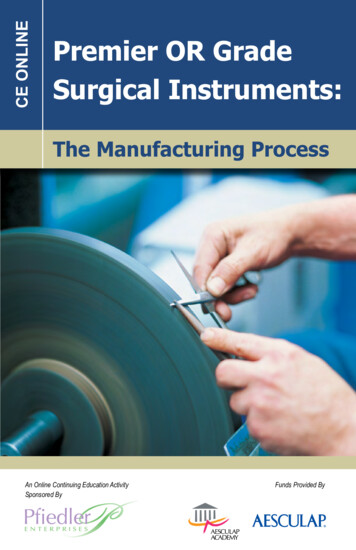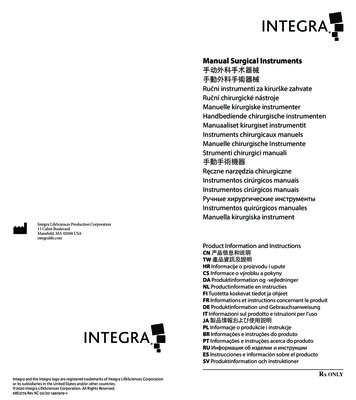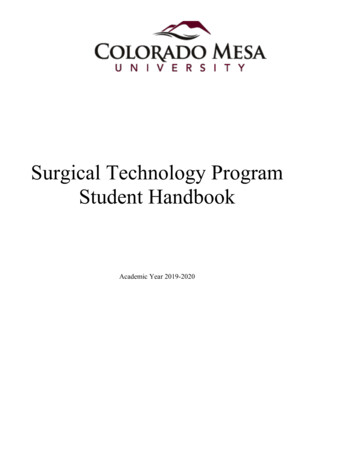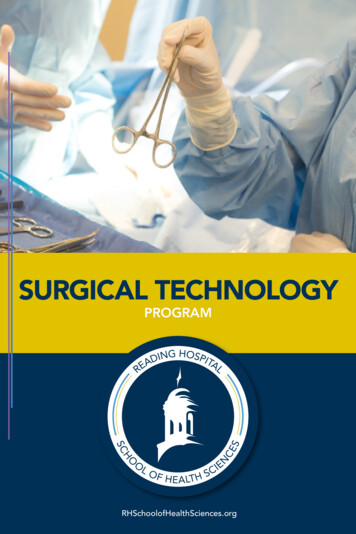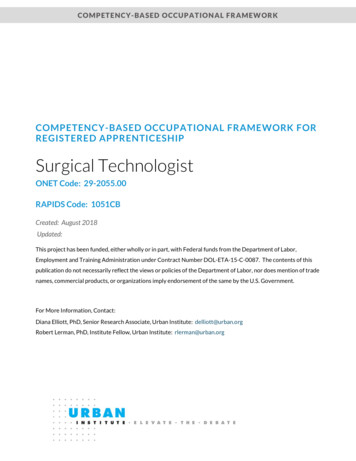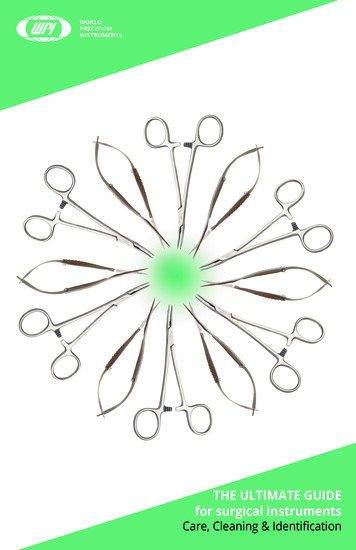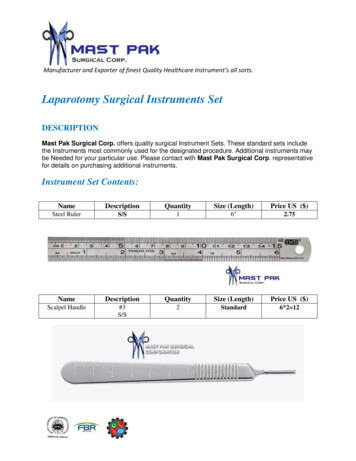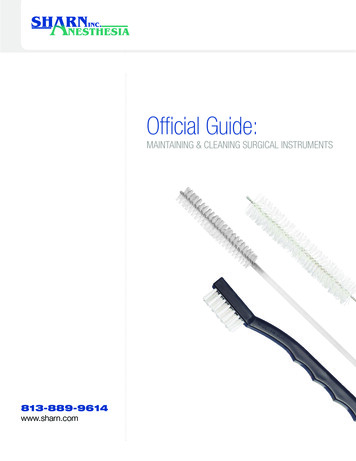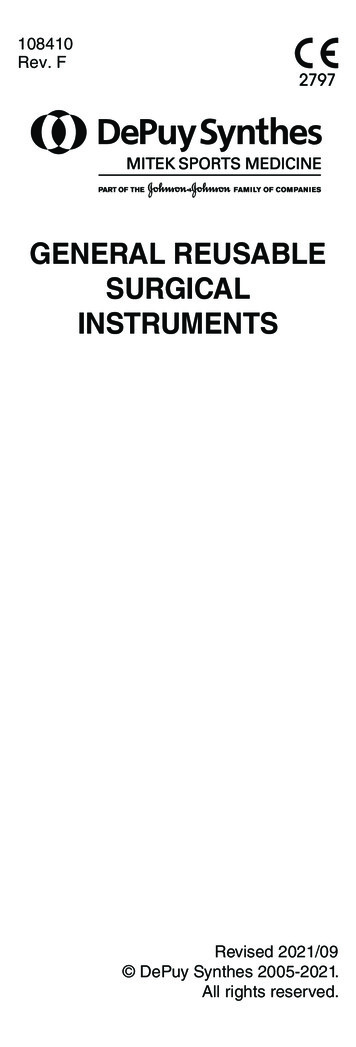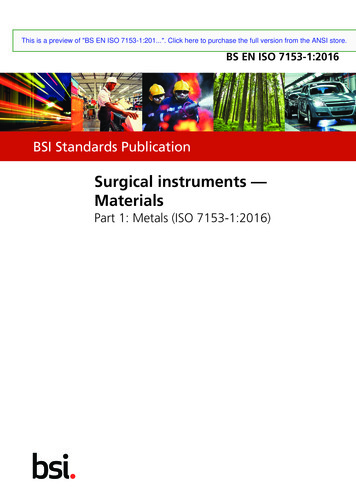
Transcription
This is a preview of "BS EN ISO 7153-1:201.". Click here to purchase the full version from the ANSI store.BS EN ISO 7153-1:2016BSI Standards PublicationSurgical instruments —MaterialsPart 1: Metals (ISO 7153-1:2016)
BS EN ISO 7153-1:2016BRITISH STANDARDThis is a preview of "BS EN ISO 7153-1:201.". Click here to purchase the full version from the ANSI store.National forewordThis British Standard is the UK implementation of EN ISO7153-1:2016. It supersedes BS EN ISO 7153-1:2001 which iswithdrawn.The UK participation in its preparation was entrusted to TechnicalCommittee CH/170, Surgical instruments.A list of organizations represented on this committee can beobtained on request to its secretary.This publication does not purport to include all the necessaryprovisions of a contract. Users are responsible for its correctapplication. The British Standards Institution 2016.Published by BSI Standards Limited 2016ISBN 978 0 580 88328 6ICS 11.040.30; 77.140.20Compliance with a British Standard cannot confer immunity fromlegal obligations.This British Standard was published under the authority of theStandards Policy and Strategy Committee on 30 November 2016.Amendments/corrigenda issued since publicationDateText affected
EN ISO 7153-1EUROPEAN STANDARDThis is a preview of "BS EN ISO 7153-1:201.". Click here to purchase the full version from the ANSI store.NORME EUROPÉENNEEUROPÄISCHE NORMOctober 2016ICS 11.040.30; 77.140.20Supersedes EN ISO 7153-1:2000English VersionSurgical instruments - Materials - Part 1: Metals (ISO7153-1:2016)Instruments chirurgicaux - Matériaux - Partie 1:Métaux (ISO 7153-1:2016)Chirurgische Instrumente - Werkstoffe - Teil 1: Metalle(ISO 7153-1:2016)This European Standard was approved by CEN on 10 September 2016.CEN members are bound to comply with the CEN/CENELEC Internal Regulations which stipulate the conditions for giving thisEuropean Standard the status of a national standard without any alteration. Up-to-date lists and bibliographical referencesconcerning such national standards may be obtained on application to the CEN-CENELEC Management Centre or to any CENmember.This European Standard exists in three official versions (English, French, German). A version in any other language made bytranslation under the responsibility of a CEN member into its own language and notified to the CEN-CENELEC ManagementCentre has the same status as the official versions.CEN members are the national standards bodies of Austria, Belgium, Bulgaria, Croatia, Cyprus, Czech Republic, Denmark, Estonia,Finland, Former Yugoslav Republic of Macedonia, France, Germany, Greece, Hungary, Iceland, Ireland, Italy, Latvia, Lithuania,Luxembourg, Malta, Netherlands, Norway, Poland, Portugal, Romania, Slovakia, Slovenia, Spain, Sweden, Switzerland, Turkey andUnited Kingdom.EUROPEAN COMMITTEE FOR STANDARDIZATIONCOMITÉ EUROPÉEN DE NORMALISATIONEUROPÄISCHES KOMITEE FÜR NORMUNGCEN-CENELEC Management Centre: Avenue Marnix 17, B-1000 Brussels 2016 CENAll rights of exploitation in any form and by any means reservedworldwide for CEN national Members.Ref. No. EN ISO 7153-1:2016 E
BS EN ISO 7153-1:2016EN ISO 7153-1:2016 (E)This is a preview of "BS EN ISO 7153-1:201.". Click here to purchase the full version from the ANSI store.European forewordThis document (EN ISO 7153-1:2016) has been prepared by Technical Committee ISO/TC 170 “Surgicalinstruments” in collaboration with Technical Committee CEN/TC 55 “Dentistry” the secretariat of whichis held by DIN.This European Standard shall be given the status of a national standard, either by publication of anidentical text or by endorsement, at the latest by April 2017, and conflicting national standards shall bewithdrawn at the latest by April 2017.Attention is drawn to the possibility that some of the elements of this document may be the subject ofpatent rights. CEN [and/or CENELEC] shall not be held responsible for identifying any or all such patentrights.This document supersedes EN ISO 7153-1:2000.According to the CEN-CENELEC Internal Regulations, the national standards organizations of thefollowing countries are bound to implement this European Standard: Austria, Belgium, Bulgaria,Croatia, Cyprus, Czech Republic, Denmark, Estonia, Finland, Former Yugoslav Republic of Macedonia,France, Germany, Greece, Hungary, Iceland, Ireland, Italy, Latvia, Lithuania, Luxembourg, Malta,Netherlands, Norway, Poland, Portugal, Romania, Slovakia, Slovenia, Spain, Sweden, Switzerland,Turkey and the United Kingdom.Endorsement noticeThe text of ISO 7153-1:2016 has been approved by CEN as EN ISO 7153-1:2016 without anymodification.3
BS EN ISO 7153-1:2016ISO 7153-1:2016(E) This is a preview of "BS EN ISO 7153-1:201.". Click here to purchase the full version from the ANSI store.Contents PageForeword. iv1234Scope. 1Normative references. 1Fields of application of materials. 1Materials. 8Annex A (informative) Examples of dental instruments.11Bibliography. 13 ISO 2016 – All rights reserved iii
BS EN ISO 7153-1:2016ISO 7153-1:2016(E) This is a preview of "BS EN ISO 7153-1:201.". Click here to purchase the full version from the ANSI store.ForewordISO (the International Organization for Standardization) is a worldwide federation of national standardsbodies (ISO member bodies). The work of preparing International Standards is normally carried outthrough ISO technical committees. Each member body interested in a subject for which a technicalcommittee has been established has the right to be represented on that committee. Internationalorganizations, governmental and non-governmental, in liaison with ISO, also take part in the work.ISO collaborates closely with the International Electrotechnical Commission (IEC) on all matters ofelectrotechnical standardization.The procedures used to develop this document and those intended for its further maintenance aredescribed in the ISO/IEC Directives, Part 1. In particular the different approval criteria needed for thedifferent types of ISO documents should be noted. This document was drafted in accordance with theeditorial rules of the ISO/IEC Directives, Part 2 (see www.iso.org/directives).Attention is drawn to the possibility that some of the elements of this document may be the subject ofpatent rights. ISO shall not be held responsible for identifying any or all such patent rights. Details ofany patent rights identified during the development of the document will be in the Introduction and/oron the ISO list of patent declarations received (see www.iso.org/patents).Any trade name used in this document is information given for the convenience of users and does notconstitute an endorsement.For an explanation on the meaning of ISO specific terms and expressions related to conformity assessment,as well as information about ISO’s adherence to the World Trade Organization (WTO) principles in theTechnical Barriers to Trade (TBT) see the following URL: www.iso.org/iso/foreword.html.The committee responsible for this document is ISO/TC 170, Surgical instruments.This third edition cancels and replaces the second edition (ISO 7153-1:1991), which has been extendedfrom stainless steels to metals and has been technically revised.It also incorporates the Amendment ISO 7153-1:1991/Amd 1:1999.ISO 7153 consists of the following parts, under the general title Surgical instruments — Materials:— Part 1: Metalsiv ISO 2016 – All rights reserved
BS EN ISO 7153-1:2016INTERNATIONAL STANDARD ISO 7153-1:2016(E)This is a preview of "BS EN ISO 7153-1:201.". Click here to purchase the full version from the ANSI store.Surgical instruments — Materials —Part 1:Metals1 ScopeThis part of ISO 7153 specifies metals commonly used to manufacture various types of standardsurgical instruments, including but not limited to those used in general surgery, orthopaedics anddentistry.While this part of ISO 7153 is not intended for surgical instruments used in special applications, suchas implantology and minimally invasive surgery, parts of it might be applicable to those instruments.NOTEWhen selecting the grade of steel and the shape, dimensions and delivery conditions of the rawmaterial for manufacturing surgical instruments, it is necessary to take into account factors, such as the designof the instrument or the production facilities of the manufacturer, that are not covered by this part of ISO 7153.For this reason, it is not intended, nor is it possible, for the information given in this part of ISO 7153 to removethe decision-making responsibility from the instrument manufacturer for selecting an appropriate raw productwith suitable properties; nor is it intended to preclude the use of other types of steel in the manufacture ofinstruments, such as the use of carbon steel for cutting instruments. International Standards for surgicalinstruments, when published, can be observed when making this decision as they may contain additional or newinformation to be taken into account when selecting appropriate steel grades.2 Normative referencesThe following documents, in whole or in part, are normatively referenced in this document and areindispensable for its application. For dated references, only the edition cited applies. For undatedreferences, the latest edition of the referenced document (including any amendments) applies.ISO 5832-2, Implants for surgery — Metallic materials — Part 2: Unalloyed titaniumISO 5832-3, Implants for surgery — Metallic materials — Part 3: Wrought titanium 6-aluminium4-vanadium alloyISO 6507-1, Metallic materials — Vickers hardness test — Part 1: Test methodISO 6508-1, Metallic materials — Rockwell hardness test — Part 1: Test methodEN 10088-1, Stainless steels — Part 1: List of stainless steelsASTM B 265, Standard Specification for Titanium and Titanium Alloy Strip, Sheet, and PlateASTM B 348, Standard Specification for Titanium and Titanium Alloy Bars and Billets3 Fields of application of materialsSince there are different requirements to various surgical instruments, there also have to be differentrequirements to the materials from which the instruments are manufactured. For this reason, not allof the materials listed within Clause 4 are suited to use in every type of instrument. For most typesof surgical instruments, materials are given in Tables 1 to 3 which are known from experience to besuitable for those instruments. Although it might be possible that other materials are also suited to themanufacture of some types of instruments, this is not covered by this part of ISO 7153. ISO 2016 – All rights reserved 1
surgical instruments, including but not limited to those used in general surgery, orthopaedics and dentistry. While this part of ISO 7153 is not intended for surgical instruments used in special applications, such as implantology and minimally invasive surge
